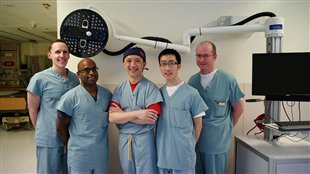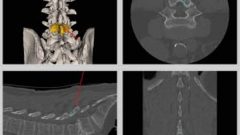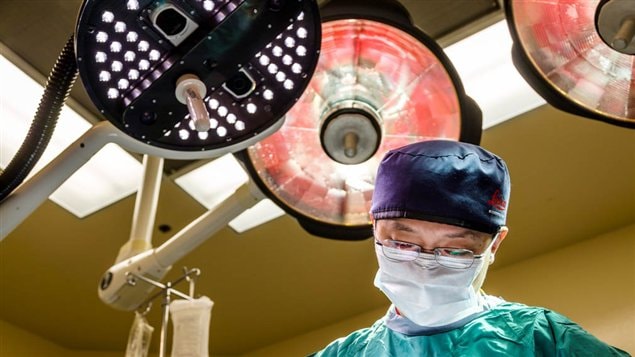Spinal and other delicate surgeries require absolute precision, such as when placing screws and support rods in the spine. A new invention greatly improves on surgeons ability to achieve that precision.
Dr Victor Yang is Canada Research Chair in Bio-photonics and bio-engineering at Ryerson University, and senior scientist in the Brain and physical Sciences at Sunnybrook Research Institute and neurosurgeon at Sunnybrook Health Sciences Centre in Toronto, Ontario
ListenThe new invention is called a 7D scanner.

Dr. Yang and his research team, includes Dr. Beau Standish, Dr. Adrian Mariampillai, Michael Leung and Dr. Peter Siegler, Dr. David Cadotte contributed many after-work hours to the project and provided input to refine, optimize and test the system. The “7D” refers to the principle that an object in three-dimensional space has six degrees of motion: forward and backward; up and down; left and right; and rotations around each of these axes. The seventh dimension is time. Dr Yang says the new system greatly improves on the time factor with its immediacy of imaging..
He notes that in developing this new concept his own background as both a neuro-surgeon and engineer gave him a unique into both sides of the creation and development requirements of the new scanner
Augmenting current computer-assisted surgery, it is a vast improvement on x-rays and CT scans which may be slightly out of date by the time a patient arrives in the operating theatre.

Example of the real time moving images created by the new scanner. Surgeons can immediately see on a screen the exact position of their instruments and any tumours, or placement of screws or support rods (courtesy Dr V Yang) CLICK to enlarge
Even the placement of the patient on the table may result in minor changes that the new device can detect. Using a light scanner and camera it “maps” the topography of the patient and immediately matches certain specific points in the patient to the pre-operation x-rays or scans. Previously doctors match these points one by one in a time consuming manner whereas the new technology does this instantaneously and precisely. Doctors use these points as references to their operation such as where to place a screw and its orientation.
The new scanner gives a full picture in, and all around the surgical field (the area operated on) in real time, helping a surgeon to ensure that any screws or rods placed in the spine are positioned exactly where necessary.to within a half a millimetre, a precision that can be critical to avoid complications in such an extremely delicate area
It also provides better images and enables more complete and accurate surgery in the case of tumour removal.
Dr Yang says the prototype testing is now almost complete and soon manufacturing will begin.
He says this new innovation continues to put Canada in the lead in such medical technology, noting that fellow surgeons and others around the world who have heard of it, are eagerly anticipating the opportunity to work with it in their own surgeries.
Funding for the research and development was provided by Natural Sciences and Engineering Research Council (NSERC), Canadian Institute of Health Research, Ryerson University, MaRS Innovation (Medical and Related Sciences), and Sunnybrook Hospital







For reasons beyond our control, and for an undetermined period of time, our comment section is now closed. However, our social networks remain open to your contributions.